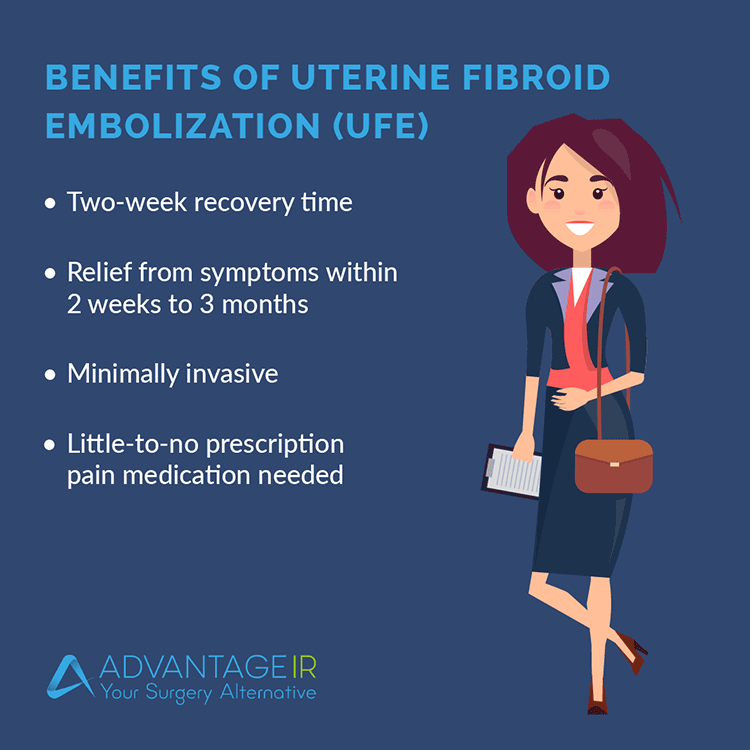Is Uterine Fibroid Removal Possible Without Surgery?
When a woman is diagnosed with uterine fibroids, doctors often recommend a hysterectomy. However, fibroid removal without surgery is possible!

Uterine fibroids can cause painful, debilitating symptoms.
To get relief, women seek advice from their primary care doctors and gynecologists. Oftentimes, they’re told the only way to get relief from their pain and bleeding is to treat the uterine fibroids with a hysterectomy.
However, this is not the only option a woman has to treat fibroids. In fact, fibroid treatment without surgery is possible.
For nearly 20 years, uterine fibroid embolization (UFE) has been a safe, minimally invasive way to successfully treat uterine fibroids.
Successful Fibroid Removal Without Surgery: How to Shrink Fibroids Fast
Also referred to as uterine artery embolization, UFE is an interventional radiology treatment that preserves a woman’s uterus.
Interventional radiology utilizes medical imaging devices to provide various non-surgical treatments. Devices can include:
- Magnetic resonance imaging (MRI)
- X-ray fluoroscopy
- Ultrasound
- Computed tomography
Uterine fibroid embolization causes fibroids to shrink by blocking their blood supply.
The doctor places a small needle puncture in the patient’s wrist, which allows him or her access to the blood vessels. Using x-ray guidance, the doctor positions a catheter into the blood vessels that feed the fibroid(s). Then, they release small gelatin beads into the vessel(s), creating a blockage.
Patients may be concerned when hearing the terms “blood vessels” and “blockage” used together since a blockage of vessels in the heart can cause severe, even fatal, damage. However, this blockage is safe. The doctor is only cutting off the blood supply to the fibroid, not to any important organs.
Once the blood supply is blocked, the fibroid will start to shrink, thereby reducing or completely eliminating the patient’s fibroid symptoms.
What is the Success Rate of UFE?
On November 25, 2002, the FDA released a clearance press release announcing the approval for a new form of treatment for uterine fibroids: Embosphere® Microspheres – the gel beads used to create the vascular blockage.
Since that time, researchers have performed multiple studies, all of which continue to show that UFE is both safe and effective. According to the New England Journal of Medicine, the success rate of uterine fibroid embolization is up to 95%.
In addition to the reduction of symptoms, patients are happy with UFE because it:
- Can improve fertility: Fibroids can impact a woman’s ability to conceive. When she undergoes a hysterectomy, the chance of pregnancy is gone forever. UFE treatment allows her the chance to still conceive naturally (as is evidenced by a 2017 study which showed that UFE is safe and effective for women who want to conceive) and increases her chances by reducing the size of uterine fibroids. Though some have questioned whether the procedure adversely impacts the ovaries, a 2019 study found the procedure does not affect ovarian circulation nor function (necessary for fertility/pregnancy).
- Doesn’t have a negative psychological impact: A 2016 study (published in 2020) found that nearly 30% of women who had a total hysterectomy dealt with anxiety afterward. Over 28% of women in the study experienced depression following their hysterectomy surgery. Due to this link, doctors and researchers recommend women try other therapies to treat uterine fibroids before opting for a
UFE is one of the best treatments for large fibroids. It doesn’t matter how many fibroids a patient has or how large they are – this procedure is effective at quickly and effectively shrinking uterine fibroids.
What Patients Can Expect Before and During the Procedure
Before the procedure, patients should talk to their doctor about all medications and supplements they’re taking, including pain killers like ibuprofen. Their doctor might recommend that they cease taking any medications that thin the blood (including over-the-counter pain medication and vitamin supplements), or those that can potentially interfere with anesthesia, prior to treatment.
On the day of treatment, the patient should bathe thoroughly and avoid applying any lotions, deodorant, or perfumes.
Patients can expect to be under the influence of anesthesia and sedatives. For this reason, patients need to have a driver to take them home after their procedure.
Relaxing medication will be provided through an IV. Once the patient is relaxed, the doctor will apply a local anesthetic to numb the catheter injection site.
The procedure takes approximately one hour to complete.
Afterward, the patient is placed in a room to recover and wake up from the sedative. A nurse will continuously evaluate the patient and once they are comfortable and it’s confirmed that they’re stable, they’ll be able to go home.
What is the Healing Time?
Within two weeks, most patients can return to their normal routine. Sticking to a healthy diet and drinking plenty of fluids will help ensure a fast recovery.
It will take 2 weeks to three months to notice an improvement in fibroid symptoms.
Directly after the treatment, patients will receive the following restrictions from their doctor:
- Shower as per normal but avoid baths
- Avoid using tampons during their next period
- Avoid sex, flights, and travel for two weeks
- Avoid heavy lifting for a few weeks or until they feel strong enough to do so
- Avoid aspirin or other blood thinners for the first week
How does this compare to hysterectomy recovery time? Full recovery after a laparoscopic hysterectomy can take up to six weeks, with the first two weeks being the most difficult and requiring prescription pain medication. It can take up to 12 weeks for women to heal enough to engage in sexual activity.

Diagnosis and Treatment of Uterine Fibroids
Uterine fibroids – also known as uterine leiomyoma – is a non-cancerous growth inside the uterus, within the muscle walls, or on the outside of the uterus. They range in size, from very tiny, to bulky masses that can change the size and shape of the uterus.
Not every woman with fibroids has symptoms. However, the most common symptoms include:
- Heavy bleeding during menstruation
- Bleeding between periods
- Pelvic pain or pressure
- Periods that last more than a week
- Frequent urination or difficulty completely emptying the bladder
- Constipation
- Backache
- Leg pains

Patients should see a doctor if they experience:
- Heavy, prolonged periods
- Overly painful periods
- Chronic pelvic pain
- Spotting/bleeding between periods
- Anemia
- Difficulty emptying their bladder
Seek immediate care for sudden, sharp pelvic pain and/or severe vaginal bleeding.
Why Should Fibroids Be Removed? Are They Dangerous?
Many women worry that fibroids make them more susceptible to cancer. According to the U.S. Department of Health and Human Services, fibroids rarely become cancerous.
Because the symptoms of uterine cancer and uterine fibroids are similar, it’s best to see a doctor right away. The diagnosis can put a woman’s mind at ease and help her seek the necessary treatment to ease her symptoms.
Should All Fibroids Be Removed?
Small fibroids don’t necessarily need treatment. If they aren’t causing any symptoms, some women choose to forego treatment. Instead, they choose the “wait-and-see” approach. If they have symptoms, they can take action. In some cases, a woman will never experience symptoms.
If a woman is experiencing any of the symptoms listed above, treatment is recommended to improve quality of life.
Is It Possible to Prevent Uterine Fibroids?
Currently, there is little scientific evidence to suggest how to prevent uterine fibroids. It’s important to note, though, that recent research suggests that managing certain modifiable risk factors can potentially help prevent fibroid development.
Patients can do this by making healthier lifestyle choices, such as:
- Losing weight (if overweight or obese)
- Maintaining a healthy weight
- Eating whole foods, including fresh fruits and vegetables
- Getting plenty of rest
- Exercising regularly
- Lowering stress levels
- Maintaining balanced hormone levels
Non-Surgical Treatment Options for Uterine Fibroid Patients
Uterine fibroid embolization is not the only hysterectomy alternative. Patients can also achieve fibroid removal without surgery in the following ways.
Radiofrequency Ablation
Using radiofrequency or cryo-technology, the doctor destroys the fibroids with heat or freezing temperatures, in addition to shrinking the blood vessels around them.
The procedure is done laparoscopically. The doctor creates small incisions in the abdomen to insert slender instruments and a camera. One of the instruments places several needles into the fibroids and heats/cools them until they’re destroyed. The tissue changes consistency from hard to soft and shrinks over the next 12 months.
Endometrial Ablation
An instrument is inserted into the uterus. Using heat, electric current, hot water, or microwave energy, the lining of the uterus (the endometrium) is destroyed. The result is reduced menstrual flow or cessation of menstruation.
Fibroids can be removed during this procedure. Unfortunately, another procedure is necessary to treat fibroids on the outside of the uterus.
Laparoscopic/Robotic Myomectomy
A myomectomy is a procedure to remove the fibroids, leaving the uterus in place. If the patient desires future pregnancies, this procedure may be indicated.
What size fibroids should be removed laparoscopically? Doctors recommend removing fibroids no larger than four inches in diameter in this manner.
During this procedure, the doctor makes small abdominal incisions in which slender instruments are inserted to detach and remove the fibroids.
Hysteroscopic Myomectomy
This procedure is an option if a patient’s fibroids are contained within the uterine cavity – not outside of it or within the muscle walls. The doctor will insert instruments into the uterus via the vagina and cervix, and remove the fibroids.
MRI-Guided Focused Ultrasound Surgery (FUS)
A new treatment for fibroids without surgery is MRI-guided FUS. This is an outpatient procedure and requires zero incisions.
Using an MRI scanner, your doctor can find and target fibroids. Then, using an ultrasound transducer, the fibroids are heated and destroyed.
As this is a new form of uterine fibroid treatment, little is known as to the long-term safety and effectiveness of this procedure.
The Surgical Route: Hysterectomy for Uterine Fibroids
Patients actually have two surgical options for the removal of uterine fibroids.
- Hysterectomy: A hysterectomy is the removal of the uterus. A full hysterectomy is the removal of the uterus and ovaries. Uterine fibroids cannot grow if there is no uterus.
- Abdominal myomectomy: In this procedure, a surgeon makes an abdominal incision (horizontal bikini-line incision is optimal, though vertical incisions are needed if the patient has a larger uterus). The incision allows them access to the uterus so they can surgically remove the fibroids. Recent research has found UFE to be as effective as abdominal myomectomy with the added benefit of more effectively controlling menorrhagia (prolonged, heavy periods).
Patients Should Find Out Which Treatment Option is Best for Their Needs
At Advantage IR, we highly recommend uterine fibroid embolization for the non-surgical treatment of uterine fibroids. The procedure is minimally invasive and requires less healing time. It has been used successfully for over 20 years. The procedure has a great track record!
However, before embarking on a specific treatment journey, patients should talk to their doctor about all their options, as well as their unique needs. It would be good to get a second opinion as well from an interventional radiologist, so patients have a well-rounded idea of whether they’re a good candidate for certain procedures and which treatments will work best for them.
The most important thing for women to remember is that a hysterectomy is not their only option. Fibroid removal without surgery is possible and, in many cases, is the optimal choice.
Would you like to learn more about our minimally invasive, non-surgical approach to uterine fibroids? Contact our team to schedule a consultation.
